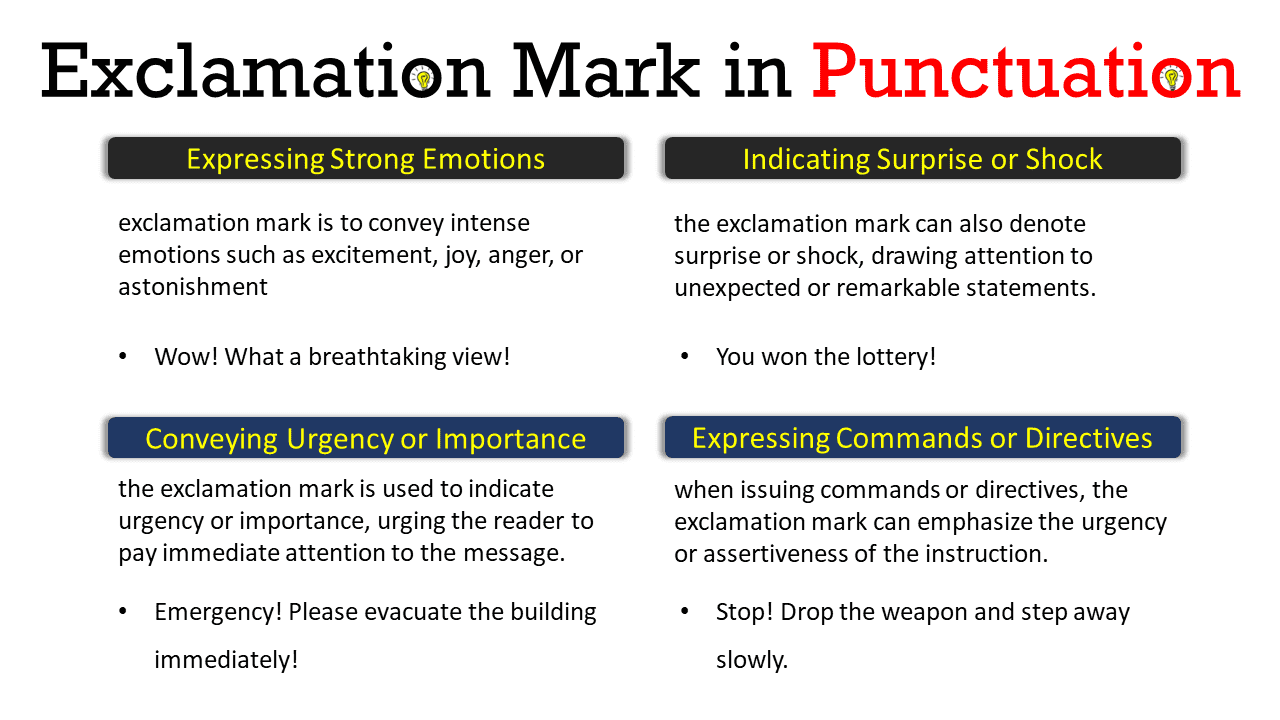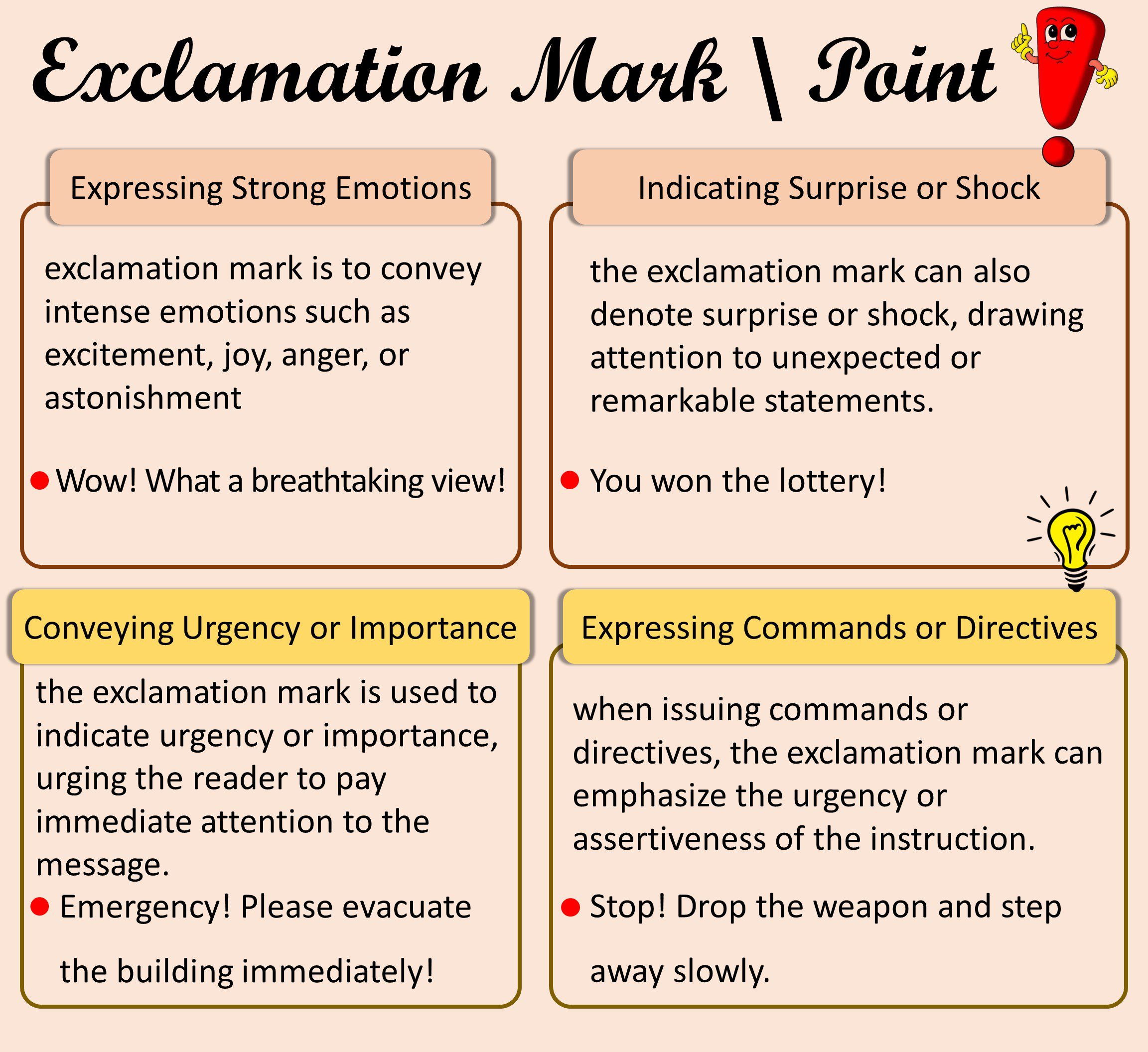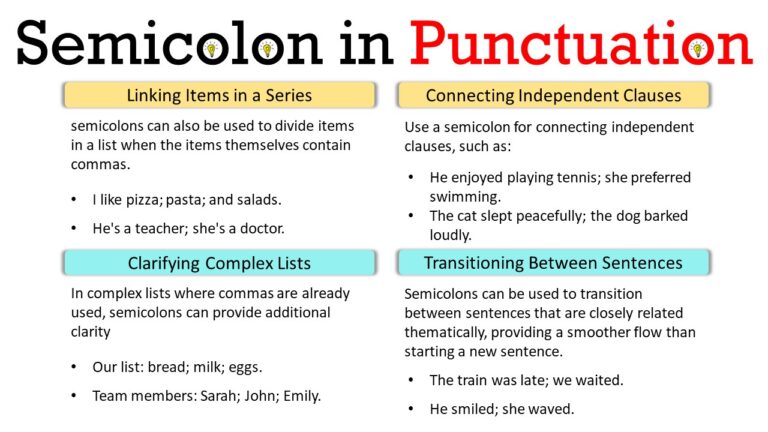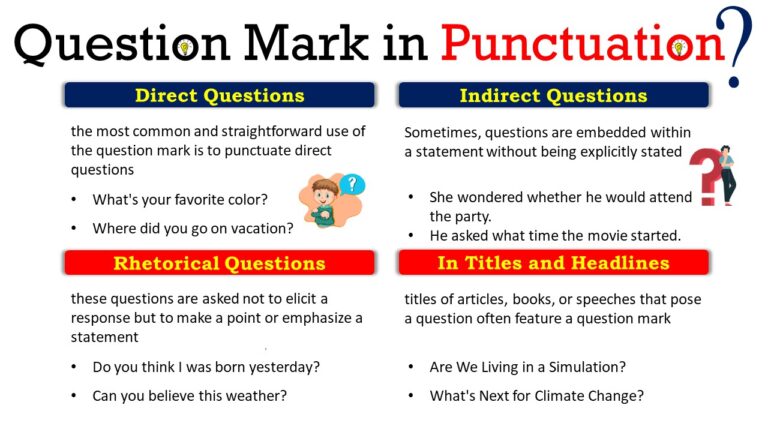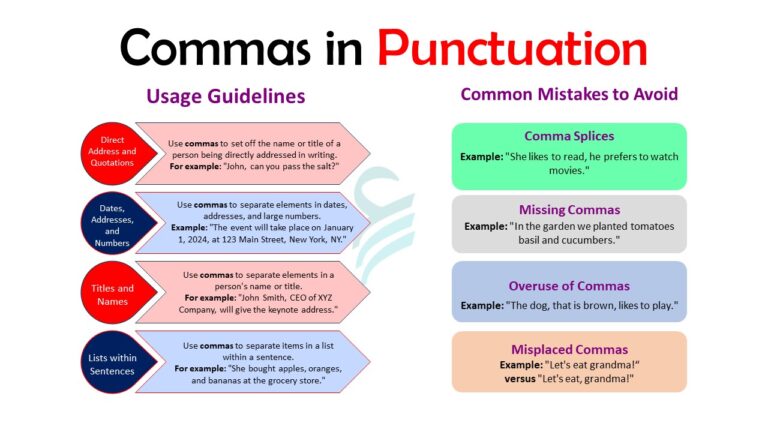In this blog post, you will learn about the exclamation mark, a punctuation sign that expresses strong emotion such as excitement or surprise. It adds emphasis to your writing, making it more engaging when used correctly. Mastering the use of the exclamation mark will help you communicate your feelings more effectively in writing.
What is an Exclamation Mark?
An exclamation mark (!) indicates a sudden order, intensity of emotion (e.g., surprise, anger, joy), or volume.
Examples:
- Stop!
- Yeah!
- Sit down!
- What a lovely view you have here!
- That’s fantastic!
- Johnny, don’t touch that!
- Help!
- Good heavens!
- Aaarrgh!
The exclamation mark, shown as “!,” is a punctuation mark that usually shows strong feelings or gives extra stress in writing. Its main job is to show excitement, surprise, urgency, or stress in a sentence. Although it seems easy to use, there are some rules and details to think about when using this punctuation mark.
Basic Uses of an Exclamation Mark
An exclamation mark is used to end an exclamatory sentence, an imperative sentence, or an interjection.
1. Exclamation mark ending an exclamatory sentence
An exclamatory sentence conveys excitement or emotion. It ends with an exclamation mark.
For example:
- You’re late!
- It’s a pike!
2. Exclamation mark ending an imperative sentence
An imperative sentence issues an order. It will end in an exclamation mark to show forcefulness.
For example:
- Get out!
- Take the dog out of the kitchen this instant!
- Please leave.
This is an imperative sentence, but it does not end with an exclamation mark because the order is not forceful.
3. Exclamation mark ending an interjection
Interjections are words used to express feelings or sudden emotions. They can be standalone or as part of a sentence (usually at the start). An interjection can end in an exclamation mark to express a strong feeling or emotion.
For example:
- Jeepers! That was close!
(This is an interjection (shaded) followed by an exclamatory sentence.)
- Overweight people now outnumber average people in America. Last month, you were fat. Now you’re average. Yay! Let’s get a pizza! (Comedian Jay Leno)
(This is an interjection (shaded) followed by an imperative sentence that also expresses joy.)
Functions and Uses of the Exclamation Mark
In this section, we are going to talk about the basic to advanced uses and functions of the exclamation mark (!) in the English language with example sentences. Each usage of the exclamation mark is explained in easy words that can be easily understood.
1. Expressing Strong Emotions
One of the primary functions of the exclamation mark is to convey intense emotions such as excitement, joy, anger, or astonishment. It adds emphasis to the sentiment expressed in a sentence.
Example:
- Wow! What a breathtaking view!
2. Indicating Surprise or Shock
The exclamation mark can also denote surprise or shock, drawing attention to unexpected or remarkable statements.
Example:
- You won the lottery!
3. Conveying Urgency or Importance
In some cases, the exclamation mark is used to indicate urgency or importance, urging the reader to pay immediate attention to the message.
Example:
- Emergency! Please evacuate the building immediately!
4. Expressing Commands or Directives
When issuing commands or directives, the exclamation mark can emphasize the urgency or assertiveness of the instruction.
Example:
- Stop! Drop the weapon and step away slowly.
5. Adding Emphasis or Intensity
Additionally, the exclamation mark can be used to intensify the overall tone of a sentence, adding emphasis to a particular word or phrase.
Example:
- I absolutely love this song!
Read more about: All Punctuation Mark Rules and Examples
Common Mistakes with Exclamation Points
In much the same way as periods, exclamation points are placed in the wrong position most often when other punctuation marks are involved. Thankfully, they do have rules.
1. Overuse:
- Incorrect: I love pizza!!! It’s the best!!! ❌
- Correct: I love pizza! It’s the best! ✔
2. Use in Formal Writing:
- Incorrect: The board meeting is at 3 pm tomorrow! ❌
- Correct: The board meeting is at 3 pm tomorrow. ✔
3. Use in Neutral Statements:
- Incorrect: The weather is nice today! ❌
- Correct: The weather is nice today. ✔
4. Combining with Question Marks:
- Incorrect: What are you doing tonight?! ❌
- Correct: What are you doing tonight? ✔
5. Use with Imperatives:
- Incorrect: Close the door! ❌
- Correct: Close the door. ✔
6. Use for Mild Emotions:
- Incorrect: I’m so happy about the news! ❌
- Correct: I’m so happy about the news. ✔
7. Use for Statements of Fact:
- Incorrect: The sun rises in the east! ❌
- Correct: The sun rises in the east. ✔
8. Use in Professional Correspondence:
- Incorrect: Please send the report over now! ❌
- Correct: Please send the report over now. ✔
Read more about: Full Stop or Period in English
When to Use an Exclamation Point
In written communication, an exclamation point is used to express strong feelings, excitement, surprise, urgency, or emphasis. It enlivens a sentence, drawing the reader in and highlighting the feeling expressed in the words. The following are some typical scenarios in which an exclamation point could be used:
Expressing Excitement or Joy:
Example:
- I got the job I’ve been dreaming of!
Showing Surprise or Astonishment:
Example:
- “You won the lottery!
Conveying Urgency or Alarm:
Example:
- Fire! Get out of the building now!
Indicating Enthusiasm or Appreciation:
Example:
- Thank you so much for your help!
Adding Emphasis or Intensity:
Example:
- I absolutely love this book!
Expressing Strong Approval or Disapproval:
Example:
- Fantastic job on the presentation!
Example:
- I can’t believe you did that!
When Not to Use an Exclamation Point
Exclamation points are great for emphasizing points and expressing strong feelings, but in some cases, they should be avoided in order to keep writing clear and professional. In the following situations, it’s preferable to avoid using an exclamation point:
1. Neutral Statements:
Avoid using exclamation points in neutral statements that do not express excitement or strong emotion.
Example:
- The meeting is scheduled for 2 p.m.
2. Informative Statements:
In informational or factual statements, it’s unnecessary to use exclamation points unless there is a specific reason to emphasize excitement or urgency.
Example:
- The train departs at 9:45 a.m.
3. Professional Correspondence:
In formal or professional communication, such as business emails or reports, exclamation points should be used sparingly to maintain a professional tone.
Example:
- Please review the attached document and provide feedback by Friday.
4. Directives or Commands:
While directives may convey urgency, exclamation points should be used judiciously to avoid appearing overly forceful or demanding.
Example:
- Please submit your report by the end of the day.
5. Questions:
Avoid using exclamation points at the end of questions unless they convey surprise or excitement.
Example:
- What time does the movie start?
6. Routine or Mundane Statements:
Exclamation points should not be used for routine or mundane statements that do not warrant emphasis or excitement.
Example:
- I went to the grocery store and bought some milk.
Exclamation Mark vs. Question Mark vs. Full Stop
| Symbol | Name | Function | Example |
|---|---|---|---|
| ! | Exclamation Mark | Indicates strong emotion, surprise, and urgency | Stop! |
| ? | Question Mark | Indicates a question or uncertainty | What time is it? |
| . | Full Stop (Period) | Marks the end of a declarative sentence | I am going home. |
Read more about: Full Stop or Period in English
Exclamation Point Quiz
1. What is the primary function of an exclamation point?
- A) To indicate a question
- B) To express strong emotion or emphasis
- C) To mark the end of a sentence
- D) To separate items in a list
Answer: B) To express strong emotion or emphasis
2. Which of the following sentences uses the exclamation point correctly?
- A) I can’t believe it! How did you do that.
- B) The concert was amazing! I had so much fun.
- C) Please close the door! Thank you.
- D) I wonder what’s for dinner!?
Answer: B) The concert was amazing! I had so much fun.
3. True or False: It is acceptable to use multiple exclamation points for added emphasis.
Answer: False. It is generally considered unnecessary and can appear unprofessional or overly dramatic.
4. In which of the following situations would you likely use an exclamation point?
- A) Writing a formal email to your boss
- B) Informing someone of an emergency
- C) Listing items in a grocery shopping list
- D) Signing your name at the end of a letter
Answer: B) Informing someone of an emergency
5. Which sentence does not require an exclamation point?
- A) Congratulations on your promotion!
- B) Help! I need somebody!
- C) Please pass the salt.
- D) What an incredible achievement!
Answer: C) Please pass the salt.
Exclamation Mark in Punctuation Infographics
Read More

